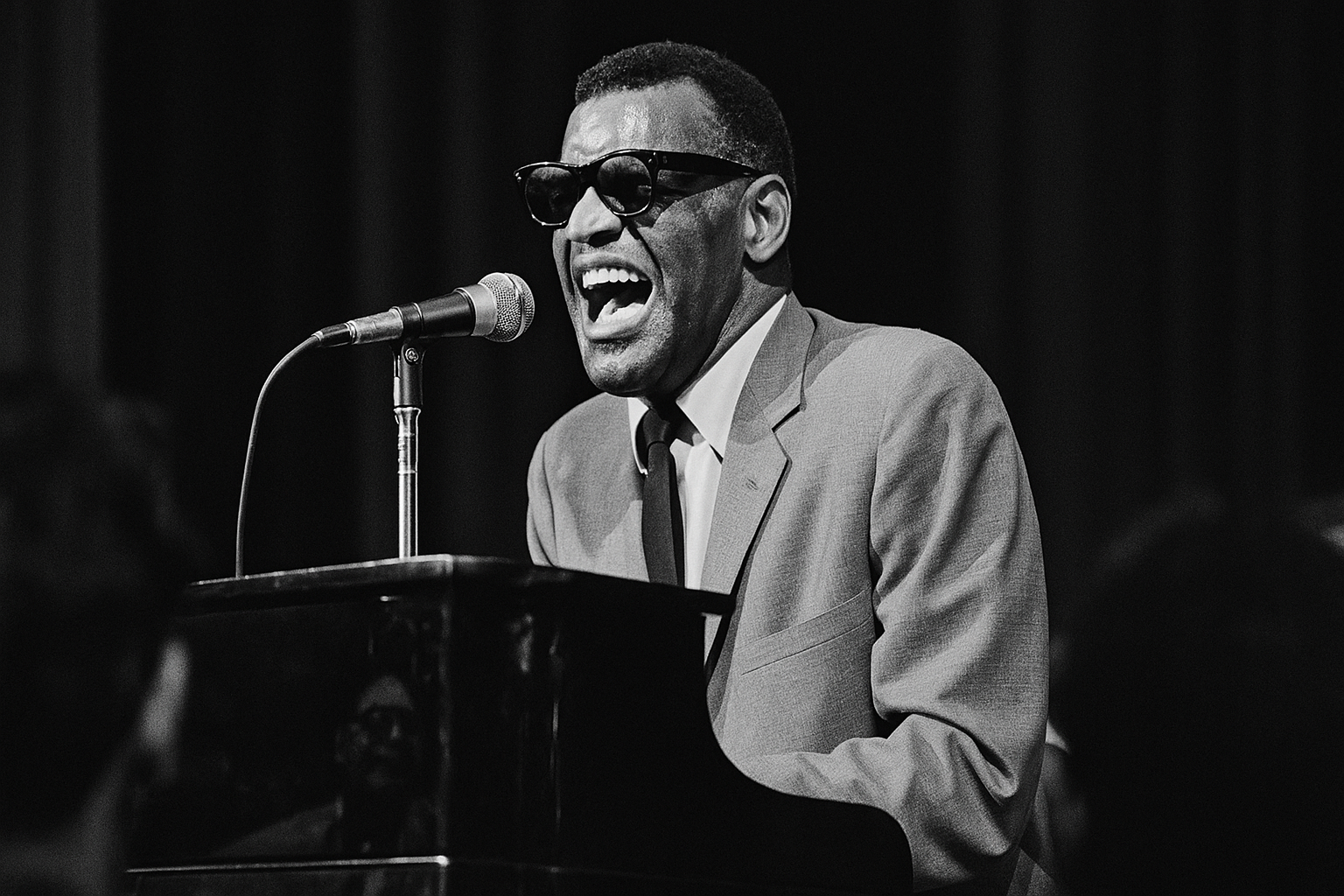The Soul of Ray Charles, the Rise of Soul Music, and the Soundtrack of Black America
When readers picked up the September 1960 issue of Ebony Magazine, they found more than just a glossy publication—they discovered a cultural milestone. Inside was a feature titled “The Soul of Ray Charles,” a sweeping profile that captured the energy, genius, and humanity of one of America’s most important musicians. At a time when the Civil Rights Movement was gaining momentum and Black artistry was reshaping mainstream culture, Ebony documented Ray Charles at the exact moment when rhythm and blues was crystallizing into a new genre: soul.
This wasn’t just an entertainment piece. It was a statement about the power of African American creativity, resilience, and pride. Through photographs, interviews, and reporting, Ebony gave its readers an intimate, unfiltered look at Charles—his roots, his struggles, his triumphs—and positioned him as both an artist and a cultural force. More than 60 years later, this issue remains a powerful artifact of African American history and a highly collectible piece for anyone interested in the intersection of music and social change.
By 1960, Ray Charles was already being hailed as a musical revolutionary. His 1955 single “I Got a Woman” blended gospel fervor with secular themes, laying the foundation for what would become known as soul music. His later smash “What’d I Say” in 1958 sold over 2.5 million singles and electrified audiences with its raw call-and-response energy. Charles was breaking barriers, not just musically, but socially—crossing over into mainstream popularity while staying rooted in the traditions of Black church music and the blues.
At the same time, the United States was in the midst of cultural and political upheaval. The sit-in movement had erupted earlier in 1960, led by young African American students demanding integration at lunch counters in Greensboro, Nashville, and across the South. Martin Luther King Jr. had just delivered his pivotal speeches on nonviolent protest, and the Civil Rights Movement was gaining national traction. Against this backdrop, Ebony’s coverage of Ray Charles resonated as more than music journalism—it was cultural affirmation.
Ebony Magazine, founded by John H. Johnson in 1945, was one of the only national publications devoted to African American life, achievement, and progress. By 1960, it had become the visual and narrative voice of Black America, reporting on everything from politics and civil rights to style, entertainment, and community life. To see Ray Charles featured so prominently was to see Black artistry recognized with dignity, depth, and celebration.
The Ebony spread on Ray Charles combined striking photography with candid reporting to create a portrait that no other magazine of the era would have dared. The cover itself featured Hazel Scott, the famed pianist and activist, highlighting how Ebony consistently elevated Black musicians to cover status at a time when mainstream media excluded them. Inside, the Ray Charles article unfolded across multiple pages of text and imagery, presenting the singer not as a novelty, but as a serious artist and cultural leader.
The photos themselves tell as much of the story as the text:
-
Stage Performances: Ebony’s photographers captured Charles mid-song, his sunglasses glinting under stage lights, sweat pouring down as he belted out “shouting blues.” One image shows fans pressed against his piano, faces transfixed, bodies swaying—an intimate glimpse of the communal power of his music.
-
Fan Frenzy: Outside Chicago’s Tivoli Theater, a crowd of hundreds jammed the sidewalks hoping to get in to see him. The caption noted that many were turned away, a testament to his explosive popularity.
-
Backstage Life: Other photos showed him joking with Lambert, Hendricks & Ross at the Newport Jazz Festival, playing dominos with friends, and relaxing with his children at home in Los Angeles.
-
On the Road: Ebony documented his demanding tour life—“one-nighters” across the country, long drives between cities, and his financial independence in arranging and managing his own shows.
This blend of performance photography, candid shots, and lifestyle images reflected Ebony’s unique editorial approach: presenting African American celebrities as fully human, multidimensional, and aspirational, while still grounding them in the cultural realities of the time.
The Ebony profile was filled with insights that revealed both the personal man and the public artist. Among its most memorable points:
-
Early Hardship and Blindness – Charles lost his sight at age seven and attended a state school for the blind in Florida, where he learned music by reading Braille one bar at a time. He credited this discipline with shaping his unique musical style.
-
Musical Roots – He began by imitating Louis Jordan and Nat King Cole before developing his own sound, a fusion of gospel, blues, and jazz that became “soul.”
-
Cultural Impact – Ebony described his music as “funk,” the jazzman’s term for blending emotional highs and lows. His ability to move audiences from joy to despair made him unique.
-
Business Acumen – Charles was not just an artist; he was a businessman. He arranged his own shows, often earning up to $100,000 per week on tour, with full creative control over his band.
-
Controversy and Criticism – The article did not shy away from discussing his arrests in Philadelphia (dismissed) or a paternity case, reflecting the challenges of fame for Black entertainers in a prejudiced society.
-
Faith and Family – Despite his grueling schedule, Charles emphasized his devotion to his wife Della and their children. He described his greatest happiness as being home and hearing his kids call him “Daddy.”
-
His Philosophy – Charles rejected the notion that music caused delinquency, insisting instead that “music is wholesome… it’s like saying that opera causes crime.”
-
Blending Sacred and Secular – Big Bill Broonzy once told Ebony, “He should be singing in a church.” Charles himself admitted the deep influence of gospel, but turned it into something new that spoke to all people.
-
Personal Taste – At home, he enjoyed listening to classical music, Miles Davis, and playing dominos with friends. He had just purchased a Los Angeles home and even considered buying a private plane to ease travel between shows.
-
Legacy in Motion – By 1960, Ray Charles was already seen as a genius in the making, with a repertoire broad enough to cross genres and break barriers, paving the way for the mainstream rise of soul music.
The September 1960 issue of Ebony Magazine is not just about Ray Charles—it’s about the era it represents. In an America wrestling with segregation, civil rights, and cultural transformation, Ebony’s decision to spotlight Charles alongside political stories, family features, and fashion spreads shows how seamlessly the magazine blended news, lifestyle, and commentary.
It also shows why Ebony was more than a magazine: it was a cultural institution. For millions of African American readers, Ebony validated their experiences, celebrated their triumphs, and provided a lens of pride at a time when mainstream publications largely excluded or caricatured Black life.
Today, vintage Ebony magazines are among the most collectible periodicals of the 20th century. Issues featuring iconic figures—Ray Charles, Martin Luther King Jr., Muhammad Ali, Billie Holiday, and more—are especially prized by collectors, historians, and families who want to preserve tangible pieces of heritage.
Why is the September 1960 issue so valuable?
-
Cultural Timing: Published at the dawn of the 1960s, this issue captures both the rise of soul music and the early momentum of the Civil Rights Movement.
-
Iconic Figure: Ray Charles was on the cusp of becoming a global legend, and Ebony preserved him at that transformative moment.
-
Visual Archive: The photos—from jammed theaters to intimate family scenes—are historical documents in themselves.
-
Historical Link: Owning this issue connects collectors directly to the excitement, tension, and creativity of Black America in 1960.
For collectors, issues like this are not just paper—they are artifacts of African American history and culture.
If you’re passionate about history, music, or African American culture, vintage magazines like this are one of the best ways to experience the past as it was lived. Reading this Ebony feature on Ray Charles is like stepping into 1960: the sights, the sounds, the language, and the energy of the era come alive on every page.
👉 Browse the full collection of original Ebony magazines here:
Original Ebony Magazines Collection
Whether you’re a seasoned collector, a music historian, or someone preserving family heritage, Ebony issues like this one are treasures. They don’t just tell stories—they are the stories, preserved for future generations.
The September 1960 issue of Ebony Magazine remains one of the most important cultural publications of its time. Its feature, “The Soul of Ray Charles,” offered an intimate, unflinching, and deeply respectful look at a man who was redefining American music. By blending powerful photography, candid reporting, and cultural insight, Ebony documented not only the rise of Ray Charles but also the broader rise of Black artistry in the mid-20th century.
Holding this issue is like holding a piece of history—when soul music was being born, when African American representation in media was rare, and when Ebony stood as a beacon of pride, progress, and possibility.
For anyone who values music, history, or culture, vintage Ebony magazines are more than collectibles. They are living artifacts of a story still unfolding—the story of Black America’s struggles, triumphs, and enduring creativity.

